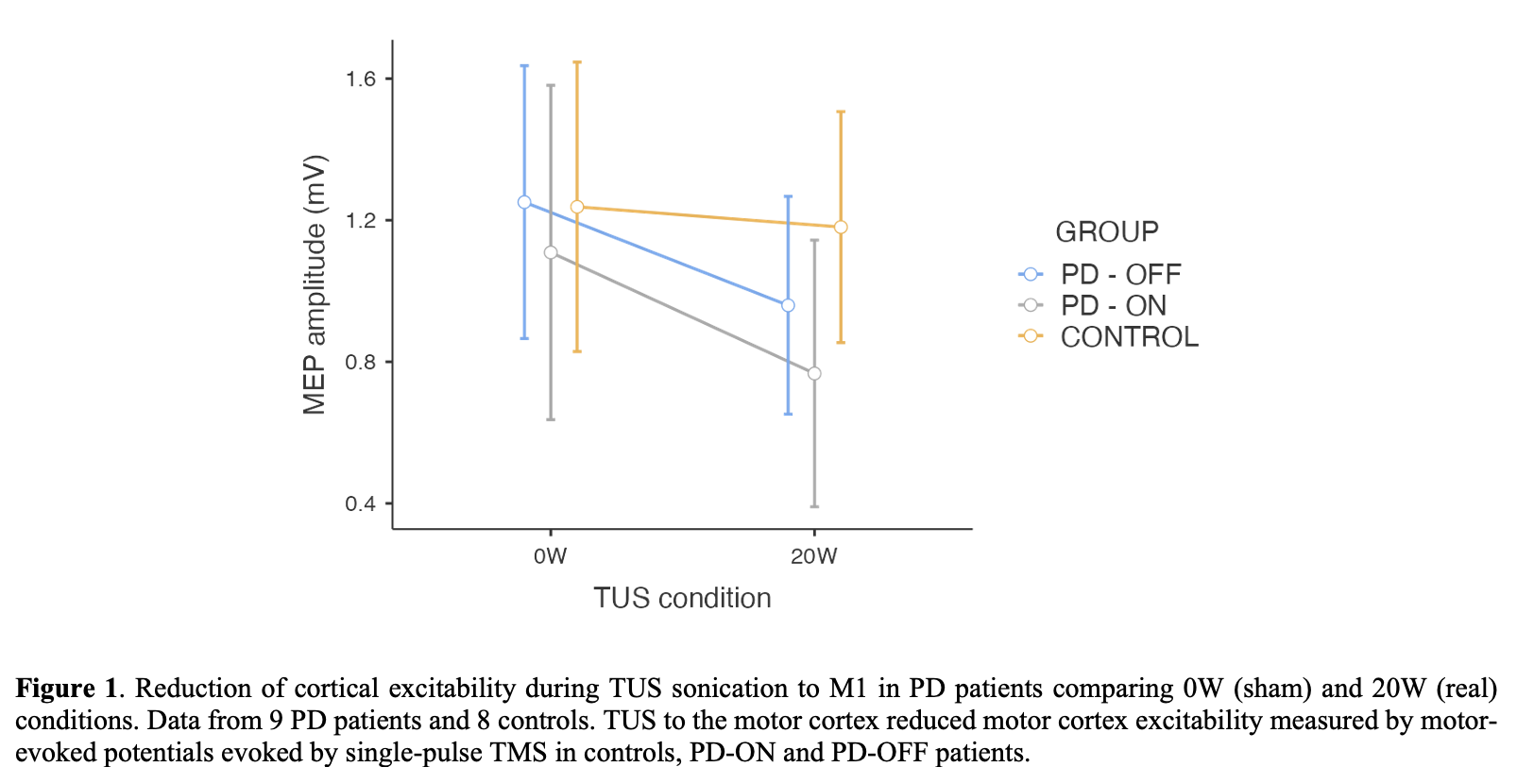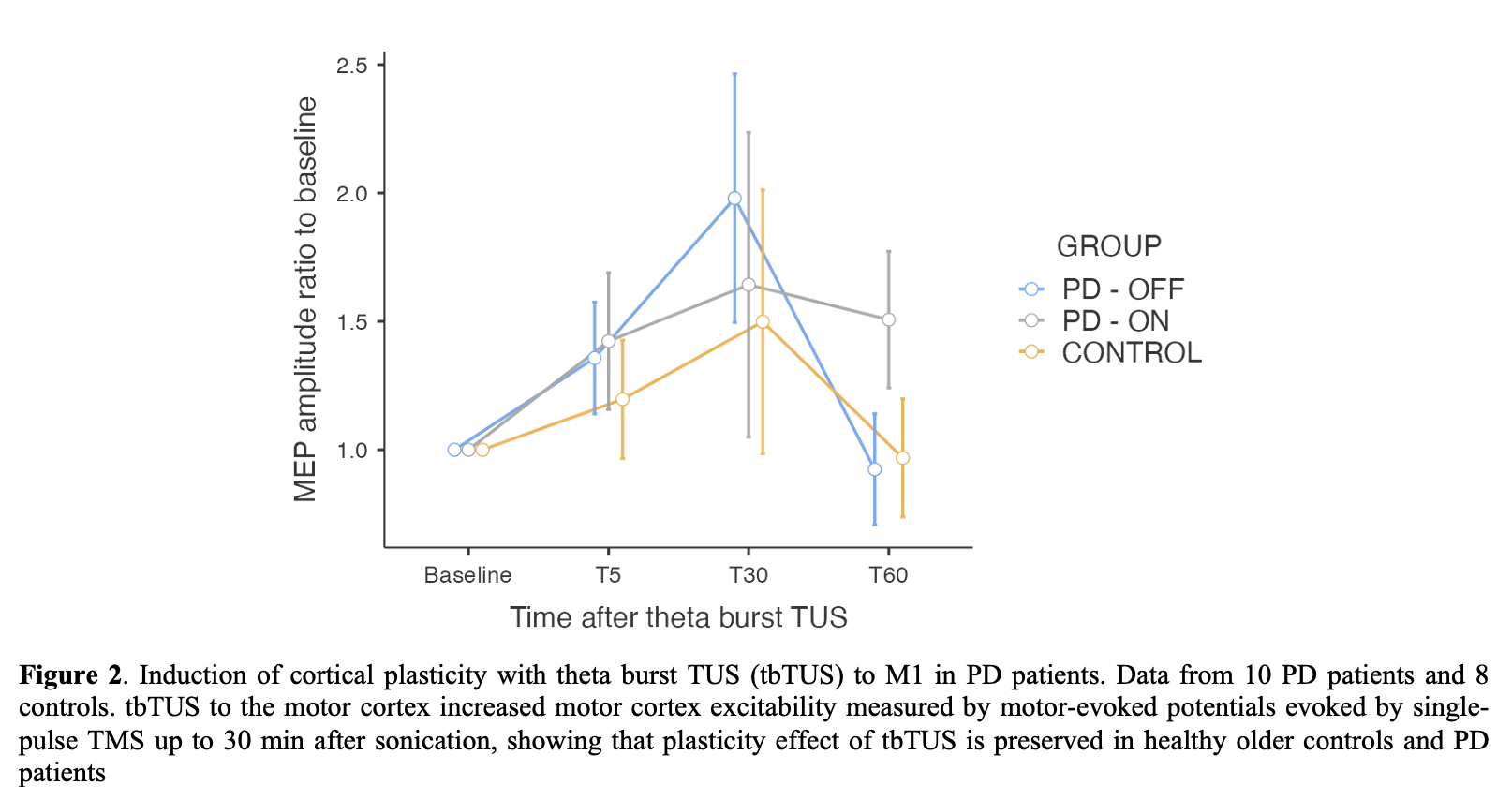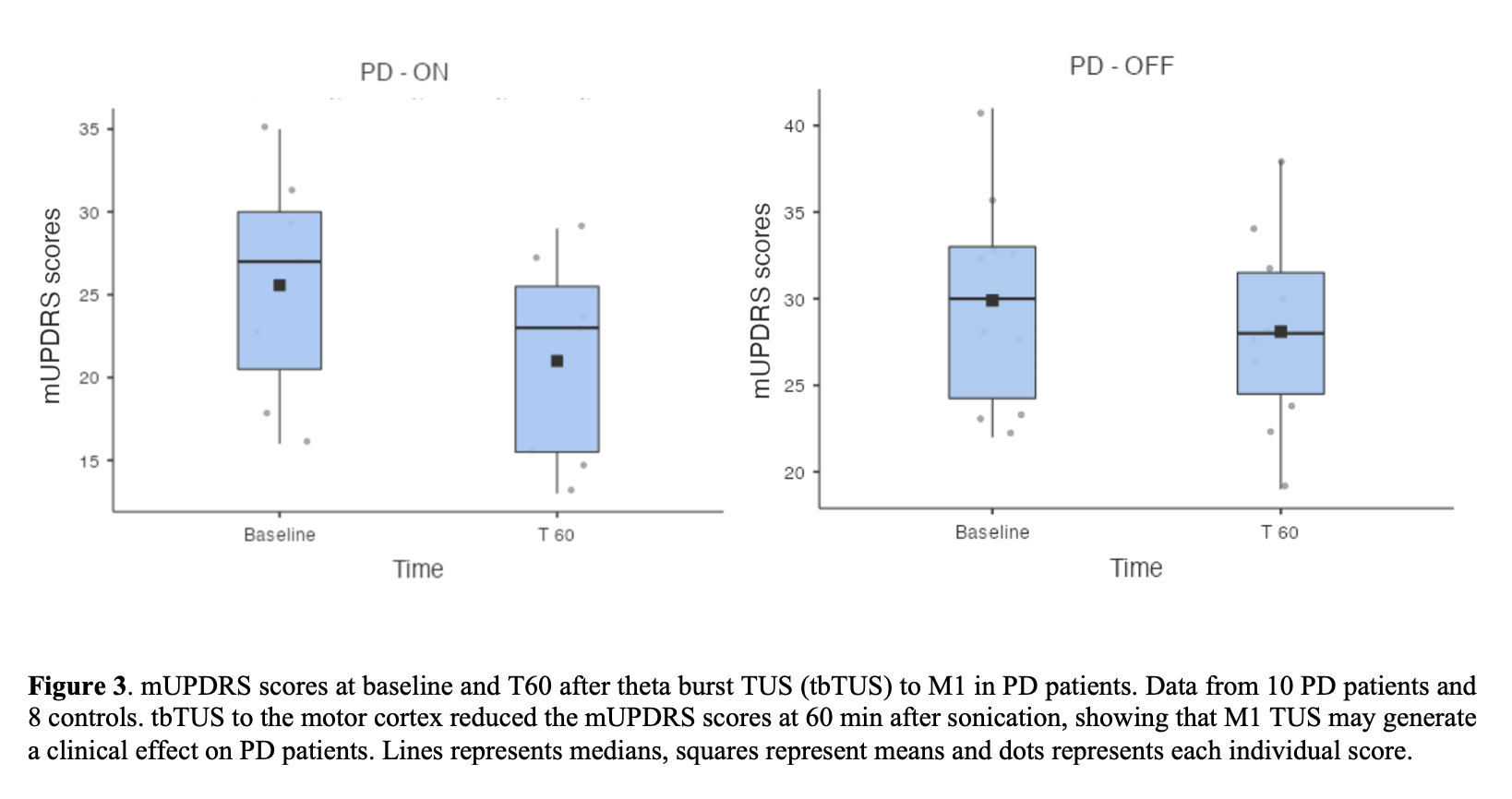Objective: Evaluate the neurophysiological and clinical effects of transcranial ultrasound stimulation (TUS) of motor cortex (M1) in PD patients.
Background: Low-intensity TUS is a novel, non-invasive brain stimulation technique with high spatial resolution.[1] TUS can transiently reduce cortical excitability during sonication (online effect).[2] TUS in a theta burst (tb) mode (tbTUS) can increase cortical excitability up to 30 minutes (offline or plasticity effect), likely due to LTP-like plasticity.[3] PD is known to have altered cortical excitability and plasticity, and benefit from non-invasive stimulation of M1.[4]
Method: We studied 10 PD patients (5F, age 61.2±10.3 [mean±SD] years) in both ON and OFF dopaminergic medication states, and 8 healthy controls (3F, age 67.8±7 years). The online TUS protocol consisted of M1 sonication at intensities of 20W (active) and 0W (sham), with simultaneous transcranial magnetic stimulation (TMS) measures of motor-evoked potential (MEP) amplitude. The offline protocol consisted of 80 seconds of M1 contralateral to the more symptomatic side with tbTUS at 20W intensity. MEP amplitudes were assessed at baseline (before tbTUS), and at 5-minutes (T5), T30, and T60 after tbTUS. Motor (m)UPDRS was evaluated in PD patients by a blinded examiner at baseline and at T60.
Results: In all groups (PD-ON, PD-OFF, control), online TUS decreased MEP amplitudes. A mixed model repeated measures ANOVA on MEP amplitudes showed an effect of TUS condition (active vs. sham; F=8.10, p=0.01), but no significant effect of group or interaction [Fig 1]. For offline effects, a mixed model repeated measures ANOVA on MEP amplitude ratios showed a significant effect of time (baseline, T5, T30, T60; F=4.08, p=0.01)[Fig 2]. There was no significant effect of group or interaction. The mUPDRS scores were significantly reduced at T60 (ON 21 ± 6.3; OFF 28 ± 5.7) compared to baseline (ON 26 ± 6.9 [mean ± SD]; OFF 30 ± 6.2) (paired t-test, ON p=0.04, OFF p=0.02)[Fig 3].
Conclusion: These preliminary findings suggest that the online effect of reduced M1 excitability with TUS and the offline effect of increased M1 excitability following tbTUS also occurs in older healthy subjects and in PD patients. The reduction of the mUPDRS scores indicate a possible clinical effect. The study is ongoing, and more subjects are being recruited.
References: 1. Darmani G, Bergmann TO, Butts Pauly K, Caskey CF, de Lecea L, Fomenko A, Fouragnan E, Legon W, Murphy KR, Nandi T, Phipps MA, Pinton G, Ramezanpour H, Sallet J, Yaakub SN, Yoo SS, Chen R. Non-invasive transcranial ultrasound stimulation for neuromodulation. Clin Neurophysiol. 2022 Mar;135:51-73.
2. Fomenko A, Chen KS, Nankoo JF, Saravanamuttu J, Wang Y, El-Baba M, Xia X, Seerala SS, Hynynen K, Lozano AM, Chen R. Systematic examination of low-intensity ultrasound parameters on human motor cortex excitability and behavior. Elife. 2020 Nov 25;9:e54497.
3. Zeng K, Darmani G, Fomenko A, Xia X, Tran S, Nankoo JF, Shamli Oghli Y, Wang Y, Lozano AM, Chen R. Induction of Human Motor Cortex Plasticity by Theta Burst Transcranial Ultrasound Stimulation. Ann Neurol. 2022 Feb;91(2):238-252.
4. Brys M, Fox MD, Agarwal S, Biagioni M, Dacpano G, Kumar P, Pirraglia E, Chen R, Wu A, Fernandez H, Wagle Shukla A, Lou JS, Gray Z, Simon DK, Di Rocco A, Pascual-Leone A. Multifocal repetitive TMS for motor and mood symptoms of Parkinson disease: A randomized trial. Neurology. 2016 Nov 1;87(18):1907-1915.
To cite this abstract in AMA style:
T. Grippe, Y. Shamli Oghli, G. Darmani, T. Arora, C. Sarica, C. Rinchon, J. Nankoo, C. Gunraj, R. Chen. Neurophysiological and Clinical Effects of Low-intensity Transcranial Ultrasound of the Motor Cortex in Parkinson’s Disease [abstract]. Mov Disord. 2022; 37 (suppl 2). https://www.mdsabstracts.org/abstract/neurophysiological-and-clinical-effects-of-low-intensity-transcranial-ultrasound-of-the-motor-cortex-in-parkinsons-disease/. Accessed October 17, 2025.« Back to 2022 International Congress
MDS Abstracts - https://www.mdsabstracts.org/abstract/neurophysiological-and-clinical-effects-of-low-intensity-transcranial-ultrasound-of-the-motor-cortex-in-parkinsons-disease/



